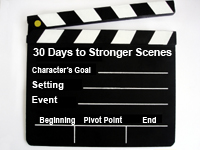Top 5 Tips for Dynamite Scenes
Guest Post By Roz Morris

 Join us on Facebook for a discussion of scenes.
Join us on Facebook for a discussion of scenes.
Have you got a scene that’s looking lifeless? Here’s how I pep it up.
Have something change.
No scene should ever go as the reader expects. If you have a character set out to buy a pint of milk and all they do is amble to the shop, buy their stuff and walk back, you’ve hit the snooze button. Instead, take that scene somewhere the reader is not expecting. It needn’t be a big twist. It could be tiny – a change of mood, a resolution to do something. But if nothing changes, the scene isn’t worth showing.
To keep the sense of progress through the story, a scene should always contain change. Otherwise it hasn’t earned its place in the story.
Make that change have consequences for the characters.
Suppose you add something to your milk-buying scene – the character realises her boyfriend claimed he bought a certain brand of cigarette from the corner shop, but that shop doesn’t sell them. So where did he get them? And isn’t it odd that they are the same brand smoked by his ex? Are they seeing each other again?
If a change has happened, it should have a lasting effect in the story. Again, it could be small, or it could set them on a new and dastardly path. Good scenes don’t exist in isolation; they affect what comes after them. And they are affected by what happened before.
If you have to fill a blank, bring something in that you introduced earlier.
In the thick of a scene, you often have to invent details off the top of your head. Where was your minor character John last night? The cinema, you write, because it doesn’t matter where he was, he’s not very important. But go back and look at what you’ve written about John before. Is there something else you already invented that you could bring in instead? Three chapters ago, did you send him, quite casually, to choir practice? Why not send him there again, or to the chemist to get throat lozenges? Now we’re fleshing John out and with very little effort.
Featured Today in Fiction Notes Stores
Bringing back ideas you used before is a great way to make the world of your story feel more solid.
Even if what you’re using is trivial it can build up – and who knows where it might lead? It’s a technique called reincorporation. It makes stories elegant and satisfying. And it adds to the feeling that everything matters.
Keep a list of everything you plucked off the top of your head because you needed to fill a blank space. You’d be surprised how useful it will be.




